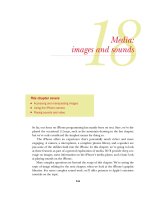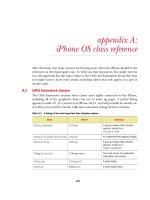Tài liệu Lập trình ứng dụng cho iPhone part 1 docx
Bạn đang xem bản rút gọn của tài liệu. Xem và tải ngay bản đầy đủ của tài liệu tại đây (647.83 KB, 14 trang )
3
Introducing the iPhone
In the 1980s Apple Computer was the leading innovator in the computer business.
Their 1984 Macintosh computer revolutionized personal computing and desktop
publishing alike. But by the 1990s the company had begun to fade; it was depend-
ing on its loyal user base and its successes in the past rather than creating the new-
est cutting-edge technology.
That changed again in 1996 when founder Steve Jobs returned to the fold. Two
years later he produced the first candy-colored iMac, a computer that walked the
line between computing device, pop culture, and fashion statement. It was just the
first of several innovations under Jobs’ watch, the most notable of which was proba-
bly 2001’s iPod. The iPod was a masterpiece of portable design. It highlighted a
simple and beautiful interface, giving users access to thousands of songs that they
could carry with them all the time. But the iPod just whetted the public’s appetite
for more.
This chapter covers
■
Understanding Apple’s iPhone technology
■
Examining the iPhone’s specifications
■
Highlighting what makes the iPhone unique
4 CHAPTER 1 Introducing the iPhone
By 2006 rumors and speculation were rumbling across the internet concerning
Apple’s next major innovation: an iPod-like mobile phone that would eventually be
called the iPhone. Given Apple’s twenty-first century record of technological innova-
tion and superb user design, the iPhone offered a new hope. It promised a new look
at the entire cellular phone industry and the possibility of improved technology that
wouldn’t be afraid to strike out in bold new directions.
Apple acknowledged that they were working on an iPhone in early 2007. When they
previewed their technology, it became increasingly obvious that the iPhone would be
something new and different. Excitement grew at a fever pitch. On the release
date—June 29, 2007—people camped outside Apple stores. Huge lines stretched
throughout the day as people competed to be among the first to own what can only be
called a smarterphone, the first of a new generation of user-friendly mobile technology.
When users began to try out their new iPhones, the excitement only mounted. The
iPhone was easy to use and it provided numerous bells and whistles, from stock and
weather reports to always-on internet access. Sales reflected the frenzied interest. Apple
sold 270,000 iPhones in two days and topped a million units in just a month and a half.
Now, a year and a half after the initial release, interest in the iPhone continues to grow.
Apple’s July 11, 2008, release of the new
3G iPhone and its public deployment of the
iPhone software development kit (SDK) promise to multiply the iPhone’s success in the
future, with even higher numbers of iPhone sales predicted for 2009 and beyond.
The
3G managed to hit a million units sold in just three days. We’re atop a new techno-
logical wave, and it has yet to crest.
But what are the technologies that made the iPhone a hit, and how can you take
advantage of them as an iPhone programmer? That will be the topic of this first chapter,
where we’ll not only look at the core specifications of the iPhone but also discuss the six
unique innovations that will make developing for the iPhone a totally new experience.
1.1 iPhone core specifications
The iPhone is more than a simple cell phone and more than a smartphone like the
ones that have allowed limited internet access and other functionality over the last sev-
eral years. As we’ve already said, it’s a smarterphone. If the iPod is any indication of mar-
ket trends, the iPhone will be the first of a whole new generation of devices but will
simultaneously stay the preeminent leader in the field because of Apple’s powerful
brand recognition and its consistent record of innovation.
Technically, the iPhone exists in two largely similar versions: the 2007 original
release and the 2008
3G release. Each is a 4.7- or 4.8-ounce computing device. Each
contains a 620 MHz ARM CPU that has been underclocked to improve battery perfor-
mance and reduce heat. Each includes 128
MB of dynamic RAM (DRAM), and from 4
to 16 GB of Flash memory. The primary differences between the two devices center on
the global positioning system (
GPS) and networking, topics we’ll return to shortly.
Programmatically, the iPhone is built on Apple’s OS X, which is itself built on top
of Unix. Xcode, the same development environment that’s used to write code for
the Macintosh, is the core of native programming for the device. Putting these two
5iPhone core specifications
elements together reveals a mature development and runtime environment of the
sort that hasn’t been seen on most other cell phones (with the possible exception of
Windows Mobile) and that upcoming smarterphone technologies won’t be able to
rival for years.
However, these general specs tell only part of the story. By looking deeper into the
iPhone’s input and output, its network, and its other capabilities, you’ll discover what
makes the iPhone a truly innovative computing platform.
1.1.1 iPhone input and output specifications
Both the input and the output capabilities of the iPhone feature cutting-edge func-
tionality that will determine how developers program for the platform. We’re going to
provide an overview of the technical specifications here; later in this chapter we’ll start
looking at the iPhone’s most unique innovations, and then return for a more in-depth
look at the input and output.
The iPhone’s input is conducted through a multi-touch-capable capacitive touch-
screen. There is no need for a stylus or other tool. Instead, a user literally taps on the
screen with one or more fingers.
The iPhone’s visual output is centered on a 3.5” 480x320-pixel screen. That’s a
larger screen than has been seen on most cell phones to date, a fact that makes the
iPhone’s small overall size that much more surprising. The device is literally almost all
screen. The iPhone can be flipped to display either in portrait or landscape mode,
meaning that it can offer either a 480-pixel-wide or a 480-pixel-tall screen.
The iPhone’s output also supports a variety of media, all at the high level that
you’d expect from the designers of the iPod. Music in a number of formats—includ-
ing
AAC (Advanced Audio Coding), AIFF (Audio Interchange File Format), Apple
Lossless, Audible,
MP3, and WAV—is supported, as well as MPEG4 videos. Generally, an
iPhone delivers CD-quality audio and high frame rate video.
The iPod Touch
A few months after the release of the original iPhone, Apple updated their iPod line
with the iPod Touch. This was a new iPod version built on iPhone technology. Like the
iPhone, it uses a 480x320 multi-touch screen and supports a mobile variant of Safari.
However, the iPod Touch is not a phone. The original version didn’t have any other
telephonic apparatus, nor did it include other iPhone features such as a camera. The
year 2008 saw the release of a new version of the iPod Touch that included an exter-
nal speaker and volume controls missing from the original 2007 model. Because of
its lack of cellular connectivity, the iPod Touch can only access the internet through
local-area wireless connections.
The developer advice in this book will largely apply to the iPod Touch as well, though
we won’t specifically refer to that device.
6 CHAPTER 1 Introducing the iPhone
Although users will load most of their audio and video straight from their com-
puter, the iPhone can play streams at a recommended 900 kbps over wi-fi, but that can
be pushed much higher on a good network. Multiple streaming rates always choose
the optimal method for the current network interface—which brings us to the ques-
tion of the iPhone’s networking capabilities.
1.1.2 iPhone network specifications
The iPhone offers two methods of wireless network connectivity: local area and wide
area.
The iPhone’s preferred method of connectivity is through a local-area wireless net-
work. It can use the 802.11g protocol to link up to any nearby wi-fi network (provided
you have the permissions to do so). This can provide local connections at high speeds
of up to 54 megabits per second (Mbit/s), thus making a network’s link to the inter-
net the most likely source of speed limits, not the iPhone itself. Everything has been
done to make local-area connectivity as simple to use as possible. Passwords and other
connection details are saved on the iPhone, which automatically reconnects to a
known network whenever it can. Switches to and from local wi-fi networks are largely
transparent and can happen in the middle of internet sessions.
The original iPhone uses the
EDGE network for wide-area wireless connectivity, fall-
ing back on this network whenever local-area wireless access isn’t available. The
EDGE
network supports speeds up to 220 kilobits per second (kbit/s). Compared to old-style
modems, which were accessing the early internet just 15 years ago, this is quite fast,
but compared to broadband connectivity it’s not that good. Although the original
iPhones have already been phased out, millions of users are still using them, and thus
EDGE network speed remains relevant.
The 3G iPhone supports the third-generation of mobile phone standards, which
are well developed in Europe but just emerging in the United States. Network speed
standards for 3G are loose, with stationary transfer speeds estimated as low as 384
kbit/s or as high as several Mbit/s. A
3G connection should generally be noticeably
quicker than EDGE but still not as fast as a local-area network. In addition, 3G iPhones
may drop back to EDGE connectivity if there’s insufficient 3G coverage in an area.
These network specifications will place the first constraints on your iPhone web
development (and will be of relevance to
SDK programs that access the internet as
well). If you’re working in a corporate environment where everyone will be accessing
your apps through a companywide wi-fi, you probably don’t need to worry that much
about how latency could affect your application. If you’re creating iPhone web pages
for wider use, however, you have to presume that some percentage of your iPhone
users will be accessing them via a wide-area wireless network. This should encourage
developers to fall back on lessons learned in the 1990s. Web pages should be smaller
and use clean style sheets and carefully created images; data should be downloaded to
the iPhone using Ajax or other technologies that allow for sporadic access to small bits
of data.
7iPhone core specifications
Thus far, we’ve discussed iPhone specifications that are relevant to both web and SDK
development. However, there’s one additional element that’s clearly web only: the
browser.
1.1.3 iPhone browser specifications
The iPhone’s browser is a mobile version of Apple’s Safari. It’s a full-fledged desktop-
grade browser with access to
DOM, CSS, and JavaScript. However, it doesn’t have access
to some client-side third-party software that you might consider vital to your web
page’s display.
The two most-used third-party software packages that aren’t available natively to
the iPhone are Flash and Java. There was some discussion of a Java release in 2008, but
the
SDK’s restriction against downloads seems to have put that effort on hold. We’ll
talk about these and other “missing technologies” more in chapter 3.
Beyond listing what’s available for the iPhone Safari browser (and what’s not),
we’ll also note that it works in some unique ways. There are numerous small changes
that optimize Safari for the iPhone. For example, rather than Safari’s standard tabbed
browsing, individual “tabs” appear as separate windows that a user can move between
as if they were individual pages.
iPhone’s Safari also features unique “chrome,” which is its rendition of toolbars.
These gray bars appear at the top and bottom of every iPhone web screen. The
chrome at the top of each page shows the current
URL and features icons for book-
marks and reloading; we’ll investigate how to hide this chrome when we look at
iPhone optimized web development in chapter 3. The chrome at the bottom contains
additional icons for moving around web pages and tabs. It’s a permanent fixture on
iPhone web pages. This iPhone chrome is more noticeable than similar bars and but-
tons on a desktop browser because of the iPhone’s small screen size.
The web vs. the SDK
Throughout the book we’re going to talk about two major categories of programming
for the iPhone: web development and SDK programming.
Web development involves the creation of web pages that work well on the iPhone.
These pages use standard web technologies such as HTML, Cascading Style Sheets
(CSS), JavaScript, PHP, Ruby on Rails, and Python; iPhone-specific technologies such
as the WebKit, iUI, and Canvas; and iPhone-specific tools like Dashcode.
SDK programming involves the design of programs that run natively on the iPhone.
These programs are written in Objective-C, compiled in Xcode, and then deployed
through the iPhone App Store.
We’ll compare the two programming methods in the next chapter; then we’ll dedicate
part 2 of this book to learning all about iPhone web development and parts 3 and 4
to digging into Apple’s iPhone SDK.
8 CHAPTER 1 Introducing the iPhone
Having discussed the general capabilities of the iPhone—its input, its output, its
network, and its browser—we’ve hit all of the major elements. But the iPhone also has
some additional hardware features that are worthy of specific note.
1.1.4 Other iPhone hardware features
Cell phones feature numerous hardware gadgets—of which a camera is the most ubiq-
uitous. The iPhone includes all of the cell phone standards, but also some neat new
elements, as outlined in table 1.1.
Of these hardware features, the ones that really stand out are the accelerometers and
the
GPS, which are not the sort of things commonly available to cell phone program-
mers. As you’ll see, they spotlight two of the elements that make the iPhone unique:
orientation awareness and location awareness. However, before we fully explore the
iPhone’s unique features, it’s useful to put the device in perspective by comparing the
iPhone to the mobile state of the art.
1.2 How the iPhone compares to the industry
Although the iPhone is an innovative new technology, it also serves as a part of a
stream of mobile development that’s been ongoing for decades. Understanding the
iPhone’s place within the industry can help us to better understand how it’s differenti-
ated from the rest of the pack.
Table 1.1 The iPhone is full of gadgets, some of them pretty standard for a modern cell phone, but
some more unique.
Gadget Notes
Accelerometers The iPhone contains three accelerometers. Their prime use is to detect an orientation
change with relation to gravity—which is to say they sense when the iPhone is rotated
from portrait to landscape mode or back. However, they can also be used to approxi-
mately map an iPhone’s movement through three-dimensional space. Could this make
the iPhone the next Wii?
Bluetooth This standard protocol for modern cell phones allows access to wireless devices. The
iPhone uses the Bluetooth 2.0+EDR protocol. Enhanced Data Rate (EDR) allows for a
transmission rate about triple that of older versions of Bluetooth (allowing for a 3.0
Mbit/s signaling rate and a practical data transfer rate of 2.1 Mbit/s).
Camera Another de facto requirement for a modern cell phone. The iPhone’s camera is 2.0
megapixel.
GPS The original iPhone doesn’t support real GPS, but instead offers the next best thing,
“peer-to-peer location detection.” This faux GPS triangulates based on the relative
locations of cell phone towers and wi-fi networks for which real GPS data exists, and
then extrapolates the user’s location based on that. Unfortunately the accuracy can
vary dramatically from a potential radius of several miles to several blocks; still, it’s
better than no GPS at all.
The 3G iPhone includes a true Assisted GPS (A-GPS), which supplements normal GPS
service with cell network information.
Although there is a difference in accuracy between the two types of GPSs, they can
both be accessed through the iPhone SDK using the same interface.
9How the iPhone compares to the industry
1.2.1 The physical comparison
Physically, the iPhone is the sort of stunningly beautiful device that you’d expect from
Apple. As we already said, it’s almost all screen, highlighting Apple’s ability to trans-
form expectations for their electronic devices.
More specifically, the iPhone has a much larger screen than most of the last-
generation cell phones, which tended to run from 320x240 pixels to 320x320 pixels
and thus had as few as half as many pixels to play with as the iPhone. Although they
had keyboards that were comparable with the iPhone’s on-screen keyboard, their
mousing methods were often based around styluses or tiny trackballs or, worse,
scrolling wheels.
We expect other cell phones to start catching up with the iPhone’s physical specs
pretty quickly, but in the meantime Apple has used those specs to create a totally new
cell phone experience—starting with its improved internet experience.
1.2.2 Competitive internet viewing
When compared to its last-generation competitors, the iPhone produces an internet
experience that is more usable, better integrated, and more constant than the stan-
dard mobile experience.
The improvements in usability stem from the innovative specifications that we’ve
already seen for input, output, and networking. On the input side, you no longer have
to use a last-generation scrolling wheel to painfully pick your way through links up
and down a page. On the output side, pages are displayed cleanly and crisply without
being broken into segments, thus allowing for a faster, more pleasant web experience.
Finally, for networking, you have the relatively good speed of the
EDGE or 3G network
combined with the ability to use lightning-fast local-area networks whenever possible.
When compared to last-generation phones plagued by molasses-like internet connec-
tions, the change is striking.
With such a strong foundation, Apple took the next step and integrated the inter-
net into the whole iPhone experience in a way that last-generation cell phones failed
to do. The iPhone includes a variety of standard programs such as a YouTube inter-
face, a stock program, a maps program, and a weather program that all provide seam-
less, automatic access to the internet. In addition, the
SDK provides simple access to
the internet for original applications.
All this functionality is supported by a constancy of internet access that is unlike
anything the smartphone industry has ever seen. Supplementing its wi-fi access, an
iPhone can access the internet through cheap add-on data plans. These plans allow
for unlimited data transfer via the web and email. Thus, users never have to think
about the cost of browsing the web. The end result is an always-on internet that, as
we’ll see, is another of the elements that makes the iPhone truly unique.
The Apple iPhone has brought mobile internet browsing out of the closet, a fact
that is going to result in notable changes to current mobile web standards.
10 CHAPTER 1 Introducing the iPhone
1.2.3 Mobile web standards
Prior to the release of the iPhone, a number of web standards were being developed for
smartphones. The .mobi top-level domain was launched in 2006, built on the Wireless
Application Protocol (WAP) and the Wireless Markup Language (WML) standard for
cut-down, mobile
HTML. In addition, the W3C Mobile Web Initiative has begun work on
standards such as mobileOK (which is meant to highlight mobile best practices).
It is our belief that the mobile standards—and even the .mobi domain—are for the
most part irrelevant when applied to the iPhone. We believe so because the iPhone
provides a fully featured desktop-class browser and has vastly improved input, output,
and networking capabilities. There are best practices for developing on the iPhone,
and we’ll talk about some of them in upcoming chapters, but they’re not the same
best practices required for leading-edge designs prior to 2007. As more smarter-
phones appear, we believe that the mobile standards being worked on now will quickly
become entirely obsolete.
This is not to say, however, that the iPhone is without limitations. It does not and
cannot provide the same experience as a desktop display, a keyboard, and a mouse.
New mobile standards for smarterphones will exist; they’ll simply be different from
those developed today.
Before completing our comparison of the iPhone to the rest of the industry, it’s
important to note that the vastly improved and integrated internet access of the
iPhone is only part of the story.
1.2.4 The rest of the story
In 2008 Apple released the next major element in the iPhone revolution, the SDK, a
developer’s toolkit that allows programmers to create their own iPhone applications.
Prior to the release of the
SDK, most cell phone development kits were proprietary
and highly specialized. The open release of the SDK could revolutionize the cell
phone industry as much as the iPhone’s web browsing experience already has.
Even that’s not the whole story. The iPhone is an innovative product, top to bot-
tom. To further highlight how it’s grown beyond the bounds of the last-generation cell
phone industry, we’ve identified six elements that make the iPhone truly unique.
1.3 How the iPhone is unique
The iPhone’s core uniqueness goes far beyond its powerful web browser and its tightly
integrated web functionality. Its unique physical form and the decisions embedded in
its software also make the device a breakthrough in cell phone technology. Six core
ideas—most of which we’ve already hinted at—speak to the iPhone’s innovation.
Understanding these elements (summarized in table 1.2) will help you in whatever
type of development you’re planning.
The idea of an always-on internet is something we already touched on earlier. How-
ever what’s notable is how successful Apple has been in pushing this idea. Huge data
transfer rates show that iPhone users are indeed always-on. In Europe,
T-Mobile
reported that their iPhone users transferred 30 times as much data as their regular
11How the iPhone is unique
users. Google has also shown a notable uptick among iPhone users, who are 50 times
more likely to conduct a search than the average internet user. Looking at overall
stats, the iPhone’s mobile Safari has already become the top mobile browser in the
United States and is quickly moving up in the international market as well. Anecdotal
evidence is consistent, as friends talk about how an iPhone user is likely at any time to
grab his or her iPhone to look up a word in Webster’s or a topic in Wikipedia, showing
off how the iPhone has become the encyclopedia of the 21st century for its users.
When Apple announced the iPhone, they highlighted its power consciousness. Users
should be able to use their iPhone all day, whether they’re talking, viewing the web, or
running native applications. Despite the higher energy costs of the
3G network, the
newest iPhone still supports 5 hours of talking or 5–6 hours of web browsing. Power-
saving tricks are built deeply into the iPhone. For example, have you noticed that
whenever you put your iPhone up to your ear, the screen goes black to conserve
power? And that it comes back on as soon as you move the iPhone away from your
ear? Power savings have also been built into the
SDK, limiting some functionality such
as the ability to run multiple programs simultaneously in order to make sure that a
user’s iPhone remains functional throughout the day.
Thanks to its
GPS (true or faux), an iPhone is location aware. It can figure out where
a user is, and developers can design programs to take advantage of this knowledge. To
preserve users’ privacy, however, Apple has limited what exactly programs can do with
that knowledge.
Just as an iPhone is knowledgeable of large-scale location changes, it also recognizes
small-scale movements, making it orientation aware. As we’ve already noted, this is thanks
to three accelerometers within the iPhone. They don’t just detect orientation; they can
also be used to measure gravity and movement. Although some of this functionality
isn’t available to web apps, sophisticated input can be accessed by
SDK programs.
Finally we come to the iPhone’s innovative input and output. Thanks to a multi-
touch screen and a uniquely scaled screen resolution, the iPhone provides a different
interactive experience from last-generation cell phones, so much so that we’ve
reserved an entire section for its discussion.
Table 1.2 The iPhone has a number of unique physical and programmatic
elements that should affect any development on the platform.
Unique Element Summary
Always-on internet A well-integrated, constant internet experience
Power consciousness A device that you can use all day
Location-aware A device that knows where it is
Orientation-aware A device that detects movements in space
Innovative input Finger-based mousing
Innovative output A high-quality scalable screen
12 CHAPTER 1 Introducing the iPhone
1.4 Understanding iPhone input and output
Although an iPhone has a native screen resolution of 480x320 pixels, web viewers
won’t see web pages laid out at that resolution. An iPhone allows a user to touch and
tap around pages in a way somewhat similar to mousing, but it provides notable differ-
ences from a mouse interface.
These differences highlight the final notable elements in the story of what makes
the iPhone unique.
1.4.1 Output and iPhone viewport
When using the iPhone for most purposes, you may note that it has a 480x320 screen
that displays very clearly. This is not a far cry from the 640x480 video displays common
on desktop computers in the late 1980s, albeit with more colors and crispness than
those early
EGA and VGA displays. Thus, as we mentioned when discussing the slower
speeds of the wide-area network, we can again fall back on the lessons of the past
when developing for the iPhone.
The iPhone’s display becomes interesting when it’s used to view web pages,
because the 480x320 display doesn’t show web pages at that size. Instead, by default a
user looks at a web page that has been rendered at a resolution of 980 pixels (with a
few exceptions, as we’ll note when talking about web development). In other words,
it’s as if users pulled a web browser up on their computer screen that was 980 pixels
wide, and then scaled it down by a factor of either 2:1 or 3:1—depending on the ori-
entation of the iPhone—to display at either 480 or 320 pixels wide.
This scaled view is what the iPhone calls a “viewport.” As you’ll see, viewport size
can be set by hand as part of a web page design, forcing a page to scale either more or
less when it’s translated onto the iPhone. However, for any web page without an
explicit viewport command, the 980-pixel size is the default.
Realizing that most pages will scale by a factor of at least two is vital to understanding
how web pages will look on an iPhone. In short, everything will be really, really small.
As a result, good web development for the iPhone depends on ensuring that words and
pictures appear at a reasonable size despite the scaling. We’ll talk about how to do that
using the viewport command,
CSS tricks, and other methods in chapter 3.
And for SDK developers: note this is an issue for you as well, since the SDK’s
UIWeb-
View
class scales the screen just like mobile Safari does. We’ll see the first example of
this in chapter 11.
1.4.2 Output and orientations
We need to consider one other important element when thinking about the iPhone
output: its ability to display in two different orientations, 480x320 or 320x480. Each
orientation has its own advantages. The portrait orientation is great for listings, while
the landscape orientation is often easier to read.
Each of these orientations also shows off the iPhone’s “chrome” in a different way.
This chrome will vary from one
SDK program to another, but it’s consistent when view-
13Understanding iPhone input and output
ing web pages in Safari, and thus we can use the latter as an example of orientation’s
impact on chrome, as shown in figure 1.1.
One of the interesting facts shown by this picture is that the web chrome takes up a
larger percentage of the iPhone screen in the landscape mode than in the portrait
mode. This is summarized in table 1.3.
The difference between the orientations isn’t nearly as bad without the
URL bar,
which scrolls off the top of the screen as users move downward, but when users first
call up a web page on the iPhone in landscape mode, they’ll only get to see a small
percentage of it. You’ll see similar issues in your
SDK development too, particularly if
you’re creating large toolbars for your applications.
Despite this limitation of landscape mode, many of the best applications will likely
shine in that layout, as the built-in YouTube application shows.
With discussions of viewports and orientations out of the way, we’ve highlighted
the most important unique elements of the iPhone output, but its input may be even
more innovative.
1.4.3 Input and iPhone mousing
As already noted, the iPhone uses a multi-touch-capable capacitive touch screen.
Users access the iPhone by tapping around with their finger. This works very differ-
ently from a mouse.
It’s perhaps most important to say, simply, that the finger is not a mouse. Generally a
finger is going to be larger and less accurate than a more traditional pointing device.
This disallows certain traditional types of
UI that depend on very precise selection. For
Mode
Chrome %
with URL
Chrome %
without URL
Portrait 26% 13%
Landscape 35% 16%
status bar: 20px
URL bar: 60px
bottom bar: 44px
visible area:
320x356
Portrait Mode
status bar: 20px
URL bar: 60px
bottom bar: 32px
visible area:
480x208
Landscape Mode
Figure 1.1 The iPhone supports
two dramatically different views,
landscape and portrait. Choosing
between them is not just a
question of which is easier to read,
but also requires thinking about
how much of each view is taken up
by toolbars and other chrome.
Mobile Safari is used here as an
example of how much room the
chrome takes up in each display.
Table 1.3 Depending on an iPhone’s
orientation, you’ll have different amounts
of screen real estate available.
14 CHAPTER 1 Introducing the iPhone
example, there are no scroll bars on the iPhone. Selecting a scroll bar with a “fat fin-
ger” would either be an exercise in frustration or would require a huge scroll bar that
would take up a lot of the iPhone’s precious screen real estate. Apple solved this prob-
lem by allowing users to tap anywhere on an iPhone screen, then “flick” in a specific
direction to cause scrolling.
Another interesting element of the touchscreen is shown off by the fact that the fin-
ger is not singular. Recall that the iPhone’s touchscreen is multi-touch. This allows users
to manipulate the iPhone with multi-finger “gestures.” The “pinch” zooming of the
iPhone is one such example. To zoom into a page, you tap two fingers on a page and
then push them apart, while to zoom in you similarly push them together.
Finally, the finger is not persistent. A mouse pointer is always on the display, but the
same isn’t true for a finger, which can tap here and there without going anywhere in
between. As you’ll see, this causes issues with some traditional web techniques that
depend on a mouse pointer moving across the screen. It also provides limitations that
might be seen throughout
SDK programs. For example, there’s no standard for cut
and paste, a pretty ubiquitous feature for any computer produced in the last couple
of decades.
Besides resulting in some changes to existing interfaces, the iPhone’s unique input
interface also introduces a number of new touches (one-fingered input) and gestures
(two-fingered input), as described in table 1.4.
When you’re designing with the
SDK, many of the nuances of finger mousing will
already be taken care of for you. Standard controls will be optimized for finger use,
and you’ll have access only to the events that actually work on the iPhone. Chapter 14
explains how to use touches, events, and actions in the
SDK. Even though some things
will be taken care of for you, as an SDK developer you’ll still need to change your way
of thinking about input to better support the new device.
When you’re developing for the web, you’ll have to be even more careful. We’ll
return to some of the ways that you’ll have to change your web designs to account for
finger mousing in chapter 3. You’ll also have to think about one other factor: internet
standards. The web currently doesn’t have any paradigms for flicks and other gestures,
Table 1.4 iPhone touches and gestures allow you to accept user input in new ways.
Input Type Summary
Bubble Touch Touch and hold. Pops up an info bubble on clickable elements.
Flick Touch Touch and flick. Scrolls page.
Flick, Two-Finger Gesture Touch and flick with two fingers. Scrolls scrollable element.
Pinch Gesture Move fingers in relation to each other. Zooms in or out.
Tap Touch A single tap. Selects.
Tap, Double Touch A double tap. Zooms a column.
15Summary
and thus the events related to them are going to be totally new. In chapter 4 you’ll
meet some brand-new iPhone-specific events, but they’re just the tip of the iceberg
and it might be years before internet standards groups properly account for them.
1.5 Summary
This concludes our overview of the iPhone. Our main goals in this chapter were to
investigate how the iPhone differs from other devices, to discover how it’s unique on
its own, and to learn how those changes might affect development work.
Based on what we’ve seen thus far, our biggest constraints in development will be
the potentially slow network, the relatively small size of the iPhone screen, and the
entirely unique input interface. Although the first two are common issues for other
networked cell phones, the third is not.
On the other hand, you’ve also seen the possibilities of many unique features, such
as the iPhone’s orientation and location awareness, though you won’t get to work with
these functions until we discuss the
SDK.
In the next chapter we’ll look at more of the differences between web develop-
ment and the SDK so that you can better choose which of them to use for any individ-
ual development project.









